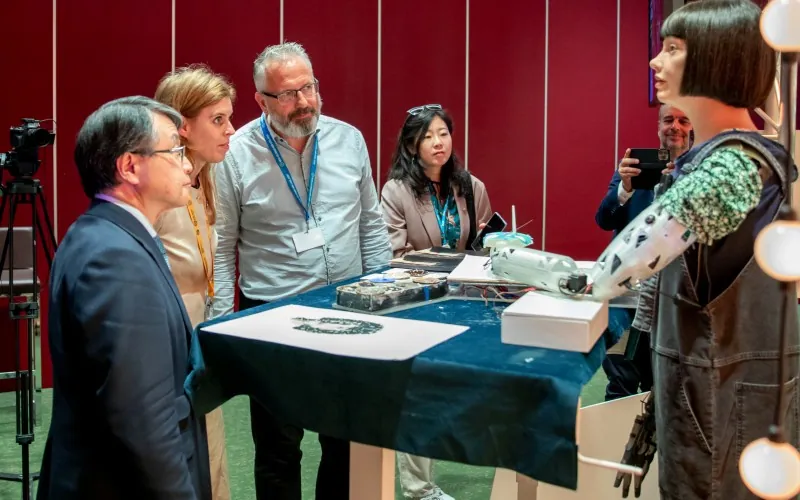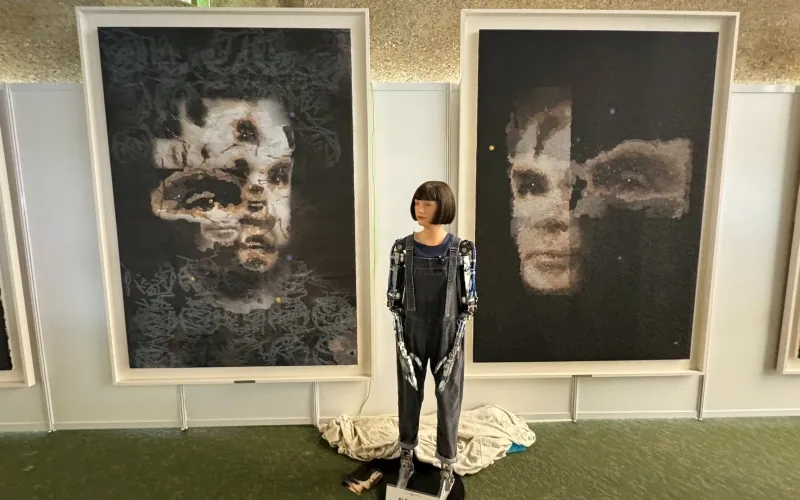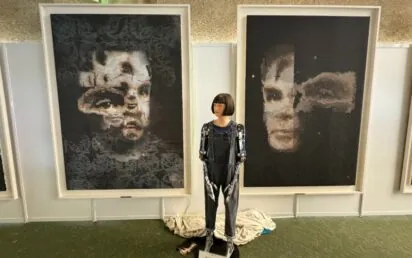Ai-Da Robot, described as the world’s first ultra-realistic robot artist, has made history as the first humanoid robot artist to have an artwork sold at auction.
AI God, a large-scale original portrait of Alan Turing, sold for over a million dollars as part of Sotheby’s Digital Art Sale.
Estimated at $120,000-180,000, the artwork was bought for $1,320,000 by an undisclosed buyer after 27 bids.
Ai-Da Robot uses an advanced AI language model to speak.
“The key value of my work is its capacity to serve as a catalyst for dialogue about emerging technologies,” it said. “AI God, a portrait of pioneer Alan Turing, invites viewers to reflect on the god-like nature of AI and computing while considering the ethical and societal implications of these advancements.
“Alan Turing recognised this potential and stares at us as we race towards this future.”
Aidan Meller, director of the Ai-Da Robot Studios, said: “This auction is an important moment for the visual arts, where Ai-Da’s artwork brings focus on artworld and societal changes, as we grapple with the rising age of AI.
“The artwork AI God raises questions about agency, as AI gains more power.”
Web Summit: How can a tech event for 70,000 people be ‘intimate’?
Explaining how Ai-Da Robot creates art, he continued: “We converse with Ai-Da, using her AI language model, about what she would like to paint. In this instance, we had a discussion with her about ‘AI for good’ which led to Ai-Da bringing up Alan Turing as a key person in the history of AI that she wanted to paint.
“We then discuss with Ai-Da how she would like to paint Alan Turing. We ask Ai-Da questions around style, colour, content, tone, texture and so on. Ai-Da then uses the cameras in her eyes to look at a picture of Alan Turing alongside her AI drawing and painting algorithms and her robotic arm to create preliminary sketches followed by several paintings of Alan Turing.
“For this painting, in addition to several ink sketches of Alan Turning, Ai-DA painted 15 individual paintings of parts of Alan Turning’s face, using acrylic and oil. Each painting is different based on how Ai-Da’s algorithm interprets the photo of Alan Turing.
“Each of these 15 paintings takes Ai-Da 6-8 hours. The canvas size for each painting is A3 and Ai-DA’s AI algorithm chooses the colours and brush strokes of the paint. For this painting 8-10 colours were chosen by Ai-DA and added to the paint pallet.

Ai-Da at the United Nations with Princess Beatrice
“The paintings [each] represent a different part of the face. When completed, Ai-Da was asked how she would like to assemble the 15 paintings in order to create a series of portraits of Alan Turning.
“Ai-Da chose 3 of the 15 portraits of Alan Turing, alongside a painting she had made of Alan Turing’s ‘Bombe Machine.’ The painting of the bombe machine can be seen in the background of the finished portrait – note the circular markings which are Ai-Da’s interpretation of the dials.
“The three paintings of Alan Turing and the painting of the Bombe Machine, all selected by Ai-Da, were then photographed and uploaded onto a computer where the final image was assembled based on a discussion with Ai-Da (using her language model) about what she wants the final artwork to look like.
“The final image is then printed using a 3D textured printer, that prints the work onto a large scale canvas. Studio assistants then add texture onto the 3D printed canvas of the artwork – this is because Ai-Da’s robotic painting arm is unable to stretch to a large scale canvas and is limited to A3 size canvas.
“There is no change to the underlying image in this process. Ai-Da then adds marks and texture onto the final canvas in order to complete the artwork. The positioning and colour of these marks are decided by Ai-Da based on having a conversation about what she wants to do.”


